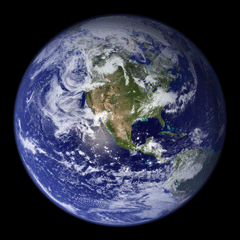Earth's Thermostat Went Awry, and the Air Grew Thin
2005 01 27
By Kenneth Chang - New York Times
 Like a chaotic pendulum, earth's climate swings, at uneven intervals, between warm and chilly ages lasting from thousands to millions of years. New research suggests that about 251 million years ago, one of those swings jolted the world so violently that oxygen became scarce, the planet's thermostat went awry and nearly all life fell into oblivion in the greatest of mass extinctions. Like a chaotic pendulum, earth's climate swings, at uneven intervals, between warm and chilly ages lasting from thousands to millions of years. New research suggests that about 251 million years ago, one of those swings jolted the world so violently that oxygen became scarce, the planet's thermostat went awry and nearly all life fell into oblivion in the greatest of mass extinctions.
Unlike a later extinction that wiped away dinosaurs, the calamity 251 million years ago appears not to have been set off by an outside force like the impact of a meteor, two teams of researchers said.
"It just seems much more consistent to be related to climate change," said Dr. Peter D. Ward, a professor of paleontology at the University of Washington and lead author of one of the papers that the journal Science published on its Web site last week. "You can explain everything without invoking any rock from space."
A second team led by Dr. Kliti Grice, a professor of organic geochemistry at Curtin University of Technology near Perth, Australia, came to similar conclusions looking at sedimentary rocks from western Australia and southern China. The die off, which marked the end of the Permian geologic period and the beginning of the Triassic, claimed more than 90 percent of species in the oceans. But it "was not an instantaneous event," Dr. Grice said.
The conclusions run counter to those of Dr. Luann Becker of the University of California, Santa Barbara. In 2001, Dr. Becker and her colleagues said they had found the calling card of a killer meteor: soccer- ball-shaped molecules known as buckyballs that contained helium with an extraterrestrial signature. Last year, Dr. Becker said remnants of the meteor's crater could be seen off the west coast of Australia.
Other geologists, however, said Dr. Becker's claimed crater looked more like a volcano, and Dr. Kenneth A. Farley, a professor of geochemistry at Caltech, reported last month at a meeting of the American Geophysical Union that his analyses of Permian-Triassic rocks had turned up no signs of extraterrestrial helium.
Dr. Ward said his examination of sediments and fossils in South Africa showed that animal species started dying out in the 10 million years leading up to the Permian-Triassic boundary. The extinction rate then jumped and remained at a higher rate for another five million years.
"I cannot say an impact did not occur," Dr. Ward said. Be he added that he found no evidence of one either. Nor did Dr. Grice.
Instead, Dr. Ward proposes that the climatic changes were wrought by geological ones. As the supercontinent Pangea pulled apart, the rearrangement of land lowered sea levels. That exposed decaying plants in the sediments to air, producing chemical reactions that dropped oxygen levels from 21 percent to 16 percent or lower. Trying to breathe at sea level then was as hard as breathing at 14,000 feet today.
The breakup of Pangea may have also set off widespread volcanic eruptions that flooded what is today Siberia with hundreds of thousands of cubic miles of lava. Carbon dioxide released by the eruptions created a greenhouse effect, and the hotter temperatures killed plants. "It's simply a world that's going climatically screwy very fast," Dr. Ward said.
Today's global warming, caused in part by fossil fuels, will not lead to an extinction like the Permian-Triassic, Dr. Ward said. Sea levels are currently rising, not falling, and plants today are more resilient.
But humanity, Dr. Ward said, should nonetheless take note that climate is capable of veering into the uninhabitable. "This makes the Permian extinction much scarier to me," he said. "It just shows climate change is dangerous and we should take it a little more seriously."
Earth Changes TV
Article From: http://www.earthchangestv.com/secure/2005/article_6631.php

|
